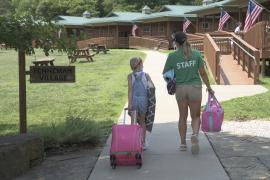The calls happen more frequently than you would imagine. “Our new arts and crafts building is not working well programmatically and is out of place. Can you help?” Replace arts and crafts with health center, director’s house, swimming pool, dining hall — you get the picture. I then ask the following question: “Did you undertake a master planning process before settling on a specific location, design, and use of the building?”
The ensuing silence is either an “oh-no moment” or they experience cognitive dissonance, meaning there is little connection between the issue they face and a solution that would have saved time, money, and angst — and created an amazing program environment that actually worked.
Master planning (MP) has been with us for generations. In its most simplistic form, it is a dynamic long-term planning tool that provides a framework for future land use. In essence, it’s an insurance policy against questionable decisions (mistakes). A traditional and well-conceived MP process allows you to leverage your facility to provide exceptional programs and avoid critical errors in terms of building placement, cost, and timeline.
For a relatively small cost (against the cost of construction), you get a road map for capital investment that ensures your program drives architecture and not the other way around. Pretty buildings are useless if they do not function as part of a healthy, overarching program plan. A hodgepodge of poorly designed buildings placed in the wrong locations is a recipe for disappointment on all fronts, especially your camper families, staff, and the donors who paid for it!
Architectural firms that specialize in camp and retreat planning do exceptional work and have created practical, purposeful, and impressive plans that have helped thousands of clients. However, many of these important, future-looking master plans end up gathering dust on a shelf. Why? Because while the plans are fabulous, the ability to translate these paper dreams into a physical reality is an altogether different matter. Going from need to plan to action is a complex process with many moving parts.
This brings us to current behaviors. Data gathered from a recent survey I undertook (thank you to the 120+ camps that participated) resulted in several data-points worth considering, as they help explain current perceptions of the MP process.
First, one-third of respondents indicated they had engaged an outside consultant to undertake a master plan over the past five years. Those who had not undertaken a plan were further asked why (Figure 1). Thirty-one percent never considered engaging a master planner, and 25 percent felt the cost was prohibitive. Interestingly, fully 38 percent indicated they had created a master plan on their own. All power to that group, however, many of the phone calls previously referenced have come from those in this third category — which is a costly scenario.
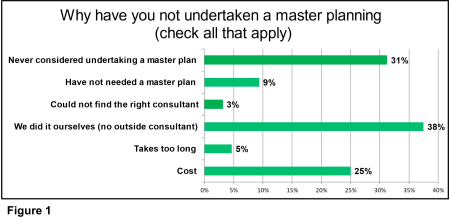
It is critical to address the issue of cost as a driver for decision-making. A master plan may cost between $40K and $150K depending on myriad factors, such as if you have accurate topographic maps or existing building inventory. It is a considerable investment, but the MP provides the key information necessary to thoughtfully spend considerably more in a smart, cohesive, and purposeful manner. This means a $10 million capital investment plan with a master plan that costs $100K represents just 1 percent of your total investment.
For those who have never gone through the MP process, it is worth taking a moment to contemplate how best to leverage it.
Master Planning 2.0
The traditional master planning approach leverages an asset (land) in a purposeful and deliberate manner through a prescribed series of activities that results in a physical plan. Master planning 2.0 utilizes a rich toolbox of actions that move you from idea to implementation — supported by a researched foundation, a steadfast commitment to implementation, and a sound business plan.
The stakes are too high for planning to be just about the land utility. Creating a master plan is a comprehensive strategic journey with three fundamental elements — three tracks, if you will, that work in parallel and must frequently crisscross to be successful.

The three tracks are operations, planning, and philanthropy. Without each element running in unison with the others, the chances of dust bunnies forming on the plan increase exponentially. Let’s briefly explore each track and the part it plays in forming a more robust MP 2.0 protocol.
1. Operations. As you move toward future needs, the reality is that you must continue to invest and improve existing operations. As you look to convince donors or lenders that you need capital investment, they will want to know that you continue to invest in the core business. The perception of your organization as a growing and stable business is crucial. Moreover, with the timeline of planning and construction between one-and-a-half and three years, it is important that the program, registration, and customer experience are prepared for the new facilities and can absorb them in due time. For example, do you wait until you complete your new arts and crafts facility to upgrade the program and staff, or do you use the lag time to address these areas in preparation for the new space? Donors want to know that their money will be well spent and have an impact beyond walls and equipment. Regardless of construction, strive to continue to improve operations, and make sure that master planning doesn’t divert attention from core business planning and growth. Positive operational momentum makes the case for ongoing investment.
2. Planning. The MP process itself comes under this banner. However, it is just one element of the planning process, which includes:
- Planning related to governance and the board of directors (or ownership group)
- Human resource planning to ensure you have the team ready to absorb the impact
- Outreach planning to ensure your customer base and broader community partners understand and support your efforts
The master planning process is just one (albeit essential) part. But pushing ahead with an MP process without understanding the impact on existing staff could result in a loss of focus and key tasks being overlooked. Similarly, a weak board will not provide the guidance, counsel, and support needed for successful outcomes.
3. Philanthropy. Unless your contractors are extraordinarily generous and donate their services (which probably isn’t going to happen), someone must pay for them. To engage major gift donors, the process must start early and involve them directly. A donor who feels some degree of project ownership is far more likely to invest. Plus, many of these folks have experience in site development and can frequently add real value to the MP process. Campaign planning should begin immediately at the first discussion of a master plan. In fact, an argument can be made that soft outreach (not a fund-raising feasibility study at this point) should be initiated in advance of master planning.
So how often do organizations use this three-track approach? Research tends to support the frustrating reality that many plans lack forward momentum and don’t come to fruition (see Figure 2). Fully 72 percent surveyed indicated either some or no elements from the plan resulted in change.
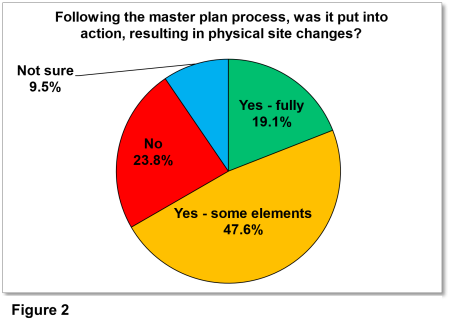
The traditional format of master planning clearly needs a makeover, and the responsibility for that falls squarely on all parties. Expecting that a master plan undertaken in isolation will drive the process forward is wishful thinking. MP 2.0 prescribes that a deliberative series of activities should take place concurrently to increase the chance of success.
Consider how those who undertook a plan in the last five years gauged value for money (see Figure 3). While 65 percent felt it represented good value, that means 35 percent were not sure or said, “No.” The “No” and “Not sure” categories likely disproportionately included those whose plans gathered dust.
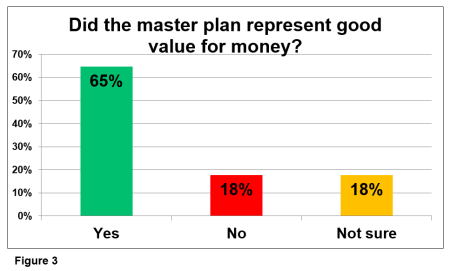
Planning in Combination
A trend toward camp and retreat center planning is intriguing and a great indicator that immersive experiences are strong and perhaps increasingly desired by people outside of just summer months.
Engaging in MP 2.0
What should you expect from a process perspective if you engage in a master planning 2.0 protocol? Figure 4 highlights the road map from start to finish. As is consistent with MP 2.0, the actual process itself is just one of the journey’s core elements. It is also important to recognize that few entities have the professional resources to undertake all elements of the MP 2.0 model, so I suggest you speak with those in the field who do this work and stretch all parties to approach the protocol through a more expansive lens. A myopic approach will result in a narrow process and lessen the chance of success.
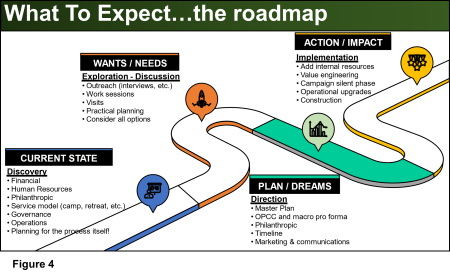
Master planning has been a crucial component of the camp and retreat space for decades. Many such plans include the prework that speaks to programmatic outreach, surveys, and focus groups that get at the nitty-gritty of wants and needs.
The bottom line is that undertaking a plan in isolation without paying attention to the other core elements is a mistake. That is not fair to the organization, the service recipients, staff, board, and, by definition, the community itself. Get moving on master planning 2.0 and cover all three tracks to ensure your plan in a true road map to reality.
David Phillips is principal of Immersive1st, a firm specializing in fundraising, planning, and visioning; governance; acute organizational analysis and program creation; and implementation and evaluation. A lifelong communal professional, his passion is doing important things with good people that make a difference (and having fun while doing it). He holds an MSW in Social Work with a focus on community organizing and development from the University of Pittsburgh. David can be reached at [email protected].
The views and opinions expressed by contributors are their own and do not necessarily reflect the views of the American Camp Association or ACA employees.

